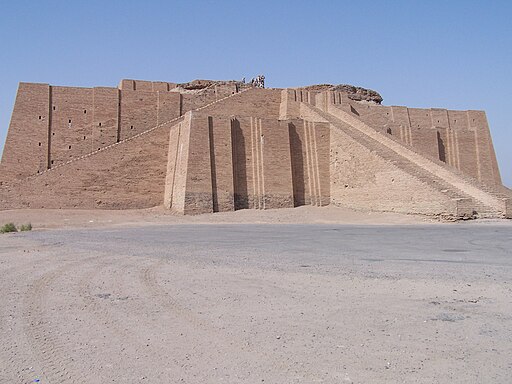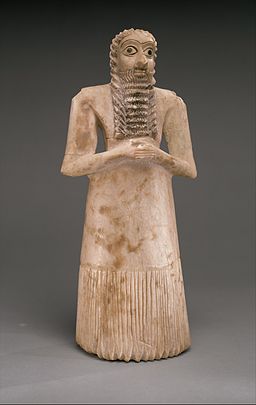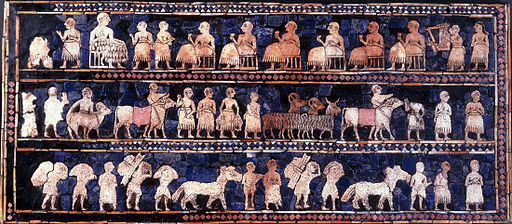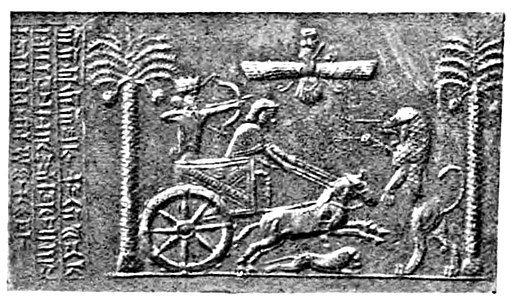Please note, that while I share videos in these lessons, I do work hard on making sure that there are no copyright infringements. Every video is linked back and credited to the original creator. Without further ado, here is Mesopotamian Art Art Lesson.
Ancient Mesopotamia Fun Facts
For the purpose of this lesson, we will be looking at approximately 3000 years: 3500 B.C. to 539 B. C. We will be looking at these 4 civilizations:
Sumer – The Sumerians were inventors, invented the wheel and first written language.
Assyria – The Assyrians were warriors, continuously fought with their neighbors and accumulated wealth of riches, including art.
Babylon – The Babylonians developed a number system, very impressive architecture.
Persia – Persia was largest city state. They were tolerant of other traditions, religions and lifestyles, enjoyed life, and were masters with metalwork.
Babylonian Numerals, Josell7, CC BY-SA 4.0, via Wikimedia Commons
What does Agriculture have to do with Art?
Development of agriculture changed everything. As agriculture developed, people were able to stop living nomadic lifestyles, and settle into a singular location, with fertile land that could be farmed. Farmers were able to provide enough food, where not everyone had to think of hunting and gathering all the time. Soon, hierarchy evolved, leading to specialization in labor and trade. Those who had aptitude for craftsmanship emerged as artists.
Why Make Art?
- The focus in art shifted from animals and nature, and instead focused on humans and human activities, god worship and government.
- From the new social hierarchy emerged kings, who wanted artists to commemorate them, and make them look good, heroic, and perfect.
Sargon of Akkad, Roemer-Pelizaeus Museum, Hildesheim, Hans Ollermann, CC BY-SA 2.0, via Wikimedia Commons
I enjoyed watching this short introductory video on Mesopotamian Art.
The Ziggurat Of Ur
- Sumerian building, mean for worship.
- Made out of mud brick, so all we have left is a footprint in most cases.
- Theocratic form of government meant that the deity is recognized as a ruler, therefore the officials would communicate the deity’s rule to the people.
Ancient Ziggurat, Iraq, Hardnfast, CC BY 3.0, via Wikimedia Commons
The Gates of Ishtar in Babylon
Gates of Ishtar, digital reconstruction, Gryffindor, Public domain, via Wikimedia Commons
View a brief video of reconstruction of Babylon and my personal favorite, a virtual tour of the Pergamonmuseum.
Votive Prayer Figures
The votive prayer figures of ancient Mesopotamia were made to express gratitude to a deity for answered prayers. They had large eyes to indicate eternal wakefulness.
Standing male worshipper, one of the twelve statues in the Tell Asmar Hoard, Metropolitan Museum of Art, CC0, via Wikimedia Commons
The Statue of Ebih-Il; c. 2400 BC, Louvre Museum, Public domain, via Wikimedia Commons
The Code of Hammurabi
- Code of law written by the Babylonian king, Hammurabi.
- Contained 282 rules.
- The punishments depended on the standing in society. Wealthy citizens received a lighter punishment as compared to the poor.
- One of the laws stated: If a man put out the eye of another man, his eye shall be put out. Hence the expression of ‘an eye for an eye.’
Code of Hammurabi, Louvre Museum, Public domain, via Wikimedia Commons
The Standard of Ur
- It is fascinating to think about it being something of a ‘comic book’.
- Recounts a series of events.
- One side is war.
- Meanwhile, the other side is peace.
Standard of Ur, Peace, Unknown author, Public domain, via Wikimedia Commons
Standard of Ur, War, Unknown author, Public domain, via Wikimedia Commons
Cylinder Seals
The Cylinder Seals were made of clay, had a hole through the center, and would be worn around a neck with a cord. It is likely that they would be rolled across the clay to be used as a signature.
Louvre Museum, Public domain, via Wikimedia Commons
Gryffindor, Public domain, via Wikimedia Commons
Walters Art Museum, Public domain, via Wikimedia Commons
Cylinder Seal of Darius The Great: I Am Here
Budge, E. A. Wallis (Ernest Alfred Wallis), Sir, 1857-1934; King, L. W. (Leonard William), 1869-1919, Public domain, via Wikimedia Commons
Before you go on to the assignment, read this short article: 11 Inventions and Discoveries In Mesopotamia.
For extra fun, you could visit the British Museum, Mesopotamian Art Wing, and go on a treasure hunt while there. You’d have to visit the British Museum, virtually, of course. Here is the link for the virtual visit, and here are four things for you to find (I will give you a hint: don’t get lost in all the rooms):
- The Standard of Ur
- A musical instrument
- A fancy headdress
- Votive Prayer Figures
Assignment
For this assignment your job is to create your own signature seal. It can include whatever represents YOU. Imagine choosing a signature made out of images that you would use to sign all your letters and communications. In modern day and age, of course, it would be texts and emails. Just think about it for a minute. What would you use as a signature? Would it be an image of your pet, family, something more representational?
Of course, I ask for it to be a drawing of what the seal would look like when rolled across the clay. However, if you have access to clay, you could absolutely go for it and make your own cylinder seal.
More Resources
More detailed video on Ziggurat of Ur













2 replies on “Mesopotamian Art”
I LOVE this craft! I will definetly do this again! It entertain me so well, a d everybodies is different! On mine I drew a carrot, because my nickname is carrots!
I RECOMEND THIS WEBSITE TO ALL MY FRIENDS! THEY LOVE IT!
Thank you very much for your kind words!